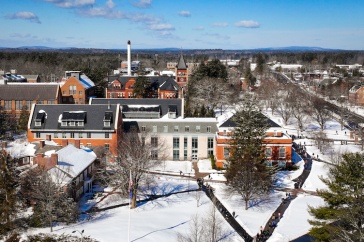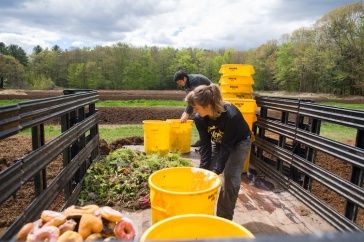
Carbon Clinic students on a site visit to the Wolfe's Neck Center for Agriculture & the Environment in Freeport, Maine. (Courtesy)
Jason Staples ’23 came to UNH intending to focus his academic work primarily on data analysis, but after gaining hands-on experience in the university’s new Carbon Clinic – where students complete carbon footprint analysis for regional organizations by utilizing several tools, including SIMAP, the university’s nitrogen and carbon accounting platform – he was inspired to add a sustainability dual major.
That decision, at least, didn’t require dissecting complicated data. It was a lot simpler than that.
“I live on this planet, and I intend to be here for a long time. So I want to help make it the best place it can be,” Staples says.
UNH remains focused on that same endeavor, as SIMAP recently underwent a significant functionality update that now allows it to calculate all Scope 3 indirect emissions – such as those that are produced by customers using a company’s products or by suppliers making products a company uses – and the impact is already being felt both by the organizations benefiting from the technology and the UNH students like Staples gaining real-world experience implementing it.
Scope 3 emissions can make up more than half of an organizations total emissions and were previously not able to be calculated by SIMAP (Sustainability Indicator Management and Analysis Platform), a one-of-a-kind, UNH-created tool utilized by more than 500 academic institutions, nonprofits, small businesses, municipalities and other organizations around the world.

The recent update changes that, allowing organizations to more completely evaluate their emissions and begin focused work to reduce them. Thanks to the Carbon Clinic, which was piloted last spring, students like Staples are often on the front lines of such efforts.
“I’ve been working in data analytics for a couple of years, but the Carbon Clinic showed me there was an actual applied practice of taking these techniques and using them to create something real and meaningful,” Staples says.
SIMAP officially launched in 2017 after evolving through several iterations from what was originally a master’s thesis at UNH in 2001. The update to include Scope 3 calculations positions SIMAP to remain an invaluable tool for carbon footprinting.
SIMAP calculates Scope 3 emissions using an EPA data set that illustrates how “for every dollar you spend on a certain category, here’s an estimate of the greenhouse gas emissions happening upstream,” Allison Leach, SIMAP co-developer and program manager at the UNH Sustainability Institute and co-leader of the Carbon Clinic, says. This allows the tool to calculate emissions associated with purchasing categories like construction, including those related to materials purchased, that it previously didn’t have the functionality for.
“It’s been a long time coming – this has been on the wish list for years now,” Leach says. “It’s so rewarding to be at this intersection between the development of a tool and helping people make real progress. It really empowers people to do their own calculations so they can work toward their own carbon footprint reduction.”
Jennifer Andrews, Sustainability Institute project director, helped develop SIMAP, co-runs the Carbon Clinic and mentors SIMAP interns. She used the example of food and the correlated calculations now possible as one of the ways in which the updated tool will help illustrate the impact of emissions.
“When you look at the food we purchase or the food we are serving in our dining halls at UNH, the footprint from that can be as large or larger than from our power plant,” Andrews says. “That kind of storytelling can be powerful, and that’s what this update allows us to do that we couldn’t do before in a data-driven way.”
"Getting to work closely with these businesses, it really feels like we're creating impact. It makes what we're doing feel even more worthwhile."
Beyond the advantages to the organizations, UNH students are also benefitting from the upgrade by gaining invaluable hands-on experience working with clients in real-world settings.
The Carbon Clinic utilizes SIMAP, allowing students to learn the ins and outs of the program while also helping local companies and other outlets arrive at real solutions to reduce emissions. SIMAP interns and Carbon Clinic participants also get to sharpen their general professional skills like time management and working collaboratively.
Brett Schultz ’26 parlayed his experience into an internship offer through the Sustainability Institute in which he’ll be performing similar work for a group of grocery stores. The sustainability dual major and the programs connected to it were some of the biggest draws that brought Schultz to UNH.
“I think UNH has a whole lot of opportunities that some college students don’t have access to, especially considering that SIMAP was developed here and some of the creators are our instructors,” Schultz says. “Getting to work closely with these businesses, it really feels like we’re creating impact. It makes what we’re doing feel even more worthwhile.”
Durga Raja ’25 came to UNH with a general interest in sustainability but said it really took shape after taking a few classes and participating in the Carbon Clinic, first as a student and this year as a peer mentor. That has also allowed her to take on more of a leadership role, including facilitating meetings and acting as the point person for the client.
“These opportunities really gave me a solid background in sustainability and helped develop the skills needed to continue,” Raja says. “I wasn’t necessarily thinking about carbon footrprinting until I joined the Carbon Clinic, but it opened my eyes to how much goes into it and how important it is.”
For clients and students alike – not to mention the environment in the bigger picture – the upgrade to include Scope 3 emissions promises to be something of a game-changer for SIMAP.
“If we are really going to tackle climate change and reduce global greenhouse gas emissions, we need to know the starting point,” Leach says. “You can’t manage what you don't measure, and this update provides a fairly significant piece we weren’t able to estimate before.”
-
Written By:
Keith Testa | UNH Marketing | keith.testa@unh.edu

















































